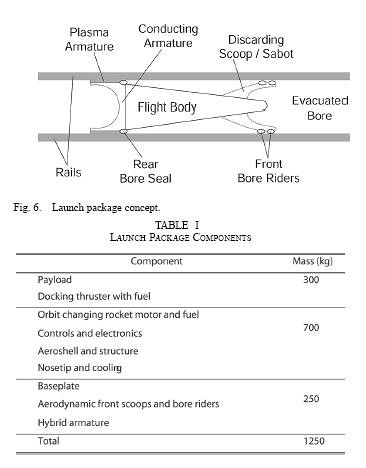
The source of this post is this 10 page IEEE paper, Launch to Space With an Electromagnetic Railgun by
Ian R. McNab, Senior Member, IEEE The cost of electricity for a launch will be negligible, as shown below. Barrel life is central to the successful economics for this system. A system might cost $1.3 billion and launch for $500/kg. Recent tests fired 7 pound projectiles at 5637 mph. Lunar escape velocity is 5,324 mph. So the truck sized system is already good enough to launch from the surface of the moon. Classic science fiction “the Moon is Harsh Mistress” by Heinlein could become reality.
Other gun launch systems were reviewed and found lacking:
Only Electromagnetic railguns seem worthy of further study for this application.
This choice was made on the basis that:
• they have already achieved 7 km/s at small scale, and 10.6 MJ at 2–3 km/s (with a test system able to go to 32 MJ) ;
• significant development is being funded for military applications;
• they offer the possibility of achieving the muzzle velocities and energies required;
• the potential cost savings seem significant based on our estimates.
Methods of accelerating large masses in large bore railguns will need to be developed, and some concepts are suggested here.
The muzzle velocity in the range needed for a moon-based launch system have already been achieved in the recent test firings. (about 2.5 km/s). Then it would just be a matter of scaling up energy linearly for heavier masses. (E=MC**2). The 10.6MJ system shot a 7 pound shot. The current 32MJ could fire 21 pounds (10kg) at the desired speed. A 320MJ system could fire 100kg payloads. Using resources available on the moon, this could serve as the forward base for sending material to Mars in support of a manned mission or to supply orbital infrastructure around the earth.
Even a scaled model would have substantial energy requirements: 10 kg at 7 km/s is a muzzle energy of 250 MJ, and with a launcher efficiency of 80%, an energy input 300 MJ would be required. This is comparable to the energy obtained from capacitor modules for the U.S. National Ignition Facility for laser fusion research.
The estimated system cost of $1.3B and a component life of 10 000 launches without replacement yields a cost of about $530/kg into orbit. It is important to note that this does not include the cost of the vehicle itself or operational costs on the Earth or in space, and these items need to be estimated.

The UTSTAR railgun tube.

Railgun launcher parts and sizes for the IEEE designed system

A chart with speed, energy and other variable tradeoffs.

Basically below 7km/s the total energy needed to launch a commercially viable amount of annual payload increases rapidly
The extension of this technology to the muzzle velocities ( 7500m/s) and energies ( 10 GJ) needed for the direct launch of payloads into orbit is very challenging, but may not be impossible. For launch to orbit, even long launchers ( 1000 m) would need to operate at accelerations 1000 gees to reach the required velocities, so that it would only be possible to launch rugged payloads, such as fuel, water, and material. Estimated launch costs could be attractively low ( $600/kg) compared with the Space Shuttle ( $20 000/kg), provided that acceptable launch rates can be achieved.
So triple the muzzle speed and increase power by 1000 times the current test level or 330 times the current 32 MJ system.
A disadvantage of gun launch is that the launch package has toleave the gun barrel at a very high velocity ( 7500 m/s) through the Earth’s atmosphere, leading to a very high aerothermal load on the projectile.
However, the current 32 MJ system is only about the size of a truck. So a nice big scramjet that could fly at Mach 10-12 could use a moderately scaled up version of the rail gun current system to fly above most of the atmosphere and then fire hardened payloads into orbit. Then less heat shielding would be needed.
To provide 500 tons/year to orbit would require 2000 launches/year—a little over five per day on average.

The launch package is cargo within a shaped shell with a small rocket.

Brian Wang is a Futurist Thought Leader and a popular Science blogger with 1 million readers per month. His blog Nextbigfuture.com is ranked #1 Science News Blog. It covers many disruptive technology and trends including Space, Robotics, Artificial Intelligence, Medicine, Anti-aging Biotechnology, and Nanotechnology.
Known for identifying cutting edge technologies, he is currently a Co-Founder of a startup and fundraiser for high potential early-stage companies. He is the Head of Research for Allocations for deep technology investments and an Angel Investor at Space Angels.
A frequent speaker at corporations, he has been a TEDx speaker, a Singularity University speaker and guest at numerous interviews for radio and podcasts. He is open to public speaking and advising engagements.

